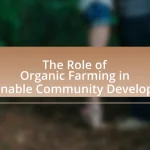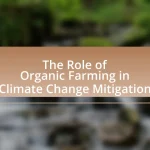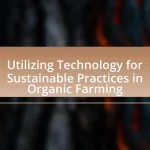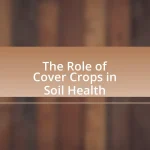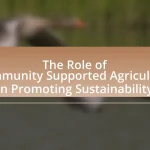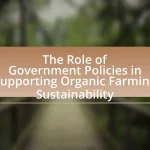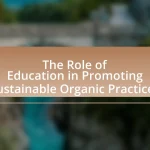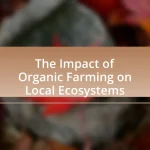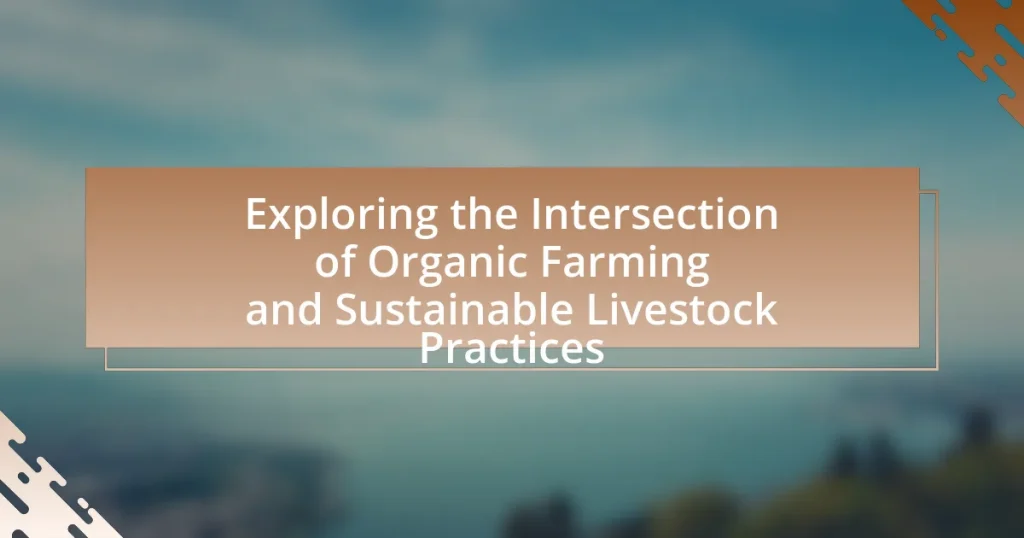The article explores the intersection of organic farming and sustainable livestock practices, highlighting their shared commitment to environmental stewardship, animal welfare, and biodiversity. It discusses how organic principles apply to livestock management, emphasizing humane treatment, natural feeding, and sustainable land use. Key practices such as rotational grazing and organic certification are examined for their impact on animal health and environmental sustainability. The article also addresses the challenges and economic barriers faced by farmers in adopting these integrated practices, while outlining the benefits of biodiversity and effective strategies for successful implementation. Overall, it underscores the importance of integrating organic farming with sustainable livestock practices to enhance ecosystem resilience and agricultural productivity.
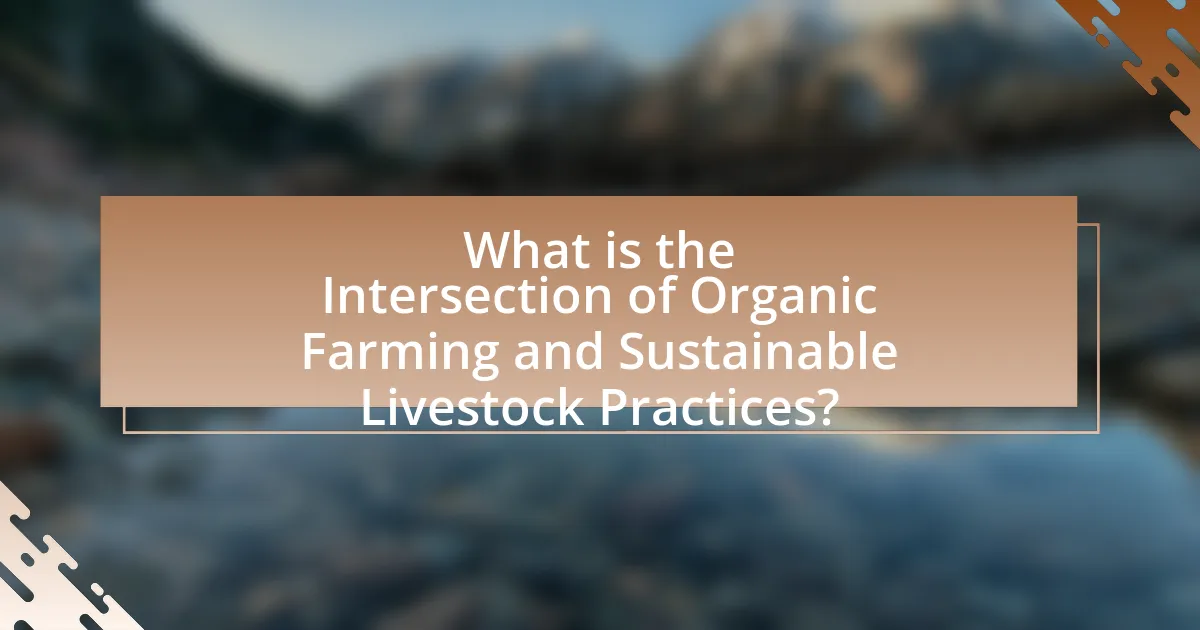
What is the Intersection of Organic Farming and Sustainable Livestock Practices?
The intersection of organic farming and sustainable livestock practices lies in their shared commitment to environmental stewardship, animal welfare, and the promotion of biodiversity. Organic farming emphasizes the use of natural inputs and methods, avoiding synthetic chemicals, which aligns with sustainable livestock practices that prioritize humane treatment and ecological balance. For instance, both approaches advocate for rotational grazing, which enhances soil health and reduces overgrazing, thereby supporting ecosystem resilience. Research indicates that integrating organic principles in livestock management can lead to improved animal health and productivity while minimizing negative environmental impacts, as seen in studies conducted by the Rodale Institute, which highlight the benefits of organic systems in enhancing soil quality and reducing greenhouse gas emissions.
How do organic farming principles apply to livestock management?
Organic farming principles apply to livestock management by emphasizing animal welfare, natural feeding practices, and sustainable land use. These principles advocate for raising animals in environments that allow for natural behaviors, which enhances their health and productivity. For instance, organic standards require that livestock have access to outdoor spaces, promoting better living conditions compared to conventional systems. Additionally, organic livestock are fed organic feed, free from synthetic pesticides and fertilizers, which supports both animal health and environmental sustainability. Research indicates that organic livestock systems can lead to improved animal welfare outcomes and reduced environmental impacts, as seen in studies published by the Rodale Institute, which highlight the benefits of organic practices in livestock management.
What are the key practices in organic livestock farming?
Key practices in organic livestock farming include providing animals with organic feed, ensuring access to outdoor spaces, and implementing rotational grazing. Organic feed must be free from synthetic pesticides and fertilizers, promoting animal health and welfare. Access to outdoor spaces allows animals to exhibit natural behaviors, which is essential for their well-being. Rotational grazing helps maintain soil health and prevents overgrazing, contributing to sustainable land management. These practices align with organic farming principles, which emphasize ecological balance and animal welfare.
How does organic certification impact livestock operations?
Organic certification significantly impacts livestock operations by imposing specific standards that enhance animal welfare and environmental sustainability. These standards require livestock to be raised without synthetic pesticides, antibiotics, or growth hormones, promoting healthier animals and reducing chemical runoff into ecosystems. According to the USDA, organic livestock must have access to the outdoors, which improves their living conditions and aligns with consumer demand for ethically produced food. Additionally, organic certification can lead to higher market prices for livestock products, as consumers are often willing to pay a premium for organic goods, thus potentially increasing profitability for certified operations.
Why is the integration of organic farming and sustainable livestock important?
The integration of organic farming and sustainable livestock is important because it enhances biodiversity and promotes ecological balance. This synergy allows for improved soil health, reduced chemical inputs, and better animal welfare, which collectively contribute to a more resilient agricultural system. Research indicates that organic farming practices can increase soil organic matter by 20-30%, leading to enhanced nutrient cycling and water retention. Additionally, sustainable livestock management practices, such as rotational grazing, can improve pasture quality and reduce greenhouse gas emissions by up to 30%. Therefore, the integration of these practices not only supports environmental sustainability but also improves food security and farmer livelihoods.
What environmental benefits arise from this integration?
The integration of organic farming and sustainable livestock practices yields significant environmental benefits, including enhanced biodiversity and improved soil health. This synergy promotes diverse ecosystems by encouraging a variety of plant and animal species, which can lead to increased resilience against pests and diseases. Additionally, sustainable livestock practices, such as rotational grazing, contribute to soil fertility and structure by preventing erosion and enhancing organic matter content. Research indicates that organic farming systems can sequester more carbon in the soil compared to conventional methods, thus mitigating climate change impacts. These practices collectively support a more sustainable agricultural system that benefits the environment.
How does this approach contribute to animal welfare?
This approach contributes to animal welfare by promoting humane treatment and natural living conditions for livestock. Organic farming practices often emphasize free-range systems, allowing animals to engage in natural behaviors, which enhances their physical and psychological well-being. Research indicates that animals raised in organic systems experience lower stress levels and better health outcomes compared to those in conventional farming. For instance, a study published in the journal “Animal Welfare” found that organic farming practices significantly improve the quality of life for farm animals by providing access to outdoor spaces and reducing the use of antibiotics, which can lead to healthier animal populations.
What challenges exist at the intersection of these practices?
Challenges at the intersection of organic farming and sustainable livestock practices include resource competition, regulatory complexities, and market access issues. Resource competition arises as both practices require land, water, and nutrients, leading to potential conflicts over their allocation. Regulatory complexities stem from differing certification standards for organic farming and sustainable livestock, which can create confusion and hinder compliance. Market access issues occur when consumers are unaware of the benefits of integrated practices, limiting demand for products that combine both approaches. These challenges highlight the need for cohesive strategies to promote synergy between organic farming and sustainable livestock practices.
What are the economic barriers to adopting organic livestock practices?
The economic barriers to adopting organic livestock practices include higher production costs, limited access to organic feed, and reduced market prices for organic products. Higher production costs arise from the need for organic certification, which can be expensive and time-consuming, as well as the increased labor required for organic farming methods. Limited access to organic feed can constrain livestock farmers, as organic feed is often more expensive and less readily available than conventional feed. Additionally, market prices for organic livestock products can fluctuate, sometimes resulting in lower profit margins compared to conventional livestock, which discourages farmers from transitioning to organic practices.
How do regulatory frameworks affect organic and sustainable practices?
Regulatory frameworks significantly influence organic and sustainable practices by establishing standards that govern production methods, labeling, and certification processes. These frameworks, such as the USDA Organic Regulations in the United States, dictate the permissible inputs and practices for organic farming, ensuring that producers adhere to specific environmental and health criteria. Compliance with these regulations not only promotes consumer trust but also encourages farmers to adopt sustainable practices that align with organic principles, such as crop rotation and reduced chemical use. Furthermore, studies indicate that regions with stringent regulatory frameworks often see higher adoption rates of sustainable practices, as farmers are incentivized to meet certification requirements to access premium markets.
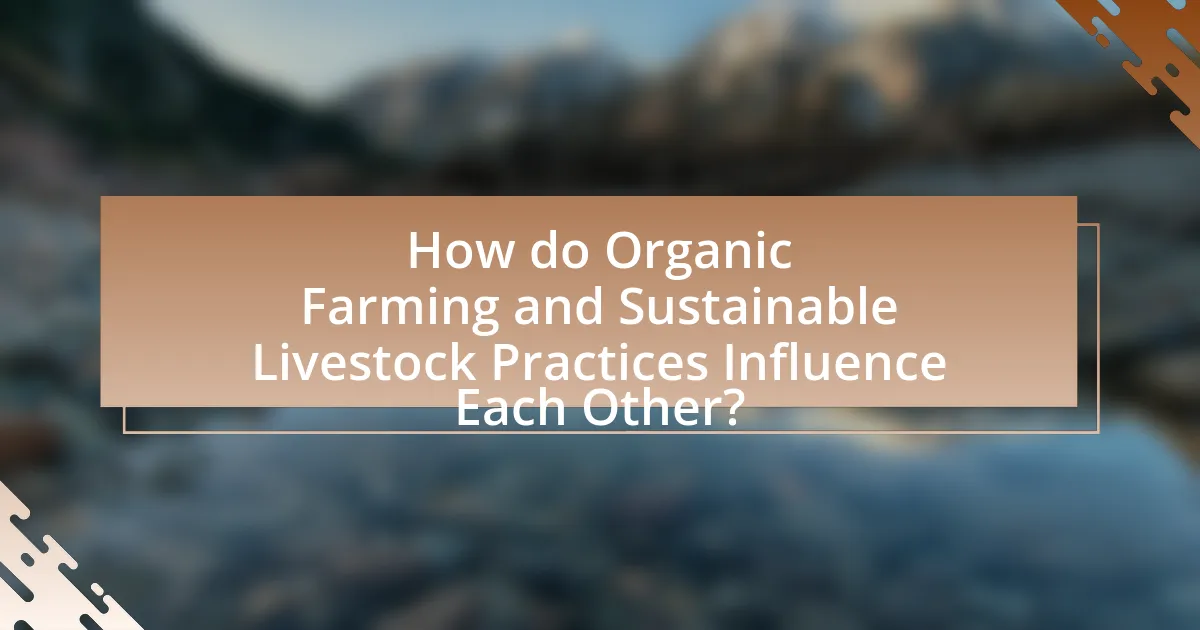
How do Organic Farming and Sustainable Livestock Practices Influence Each Other?
Organic farming and sustainable livestock practices mutually influence each other by promoting biodiversity and enhancing soil health. Organic farming emphasizes the use of natural inputs and crop rotations, which can improve the nutritional quality of feed for livestock, leading to healthier animals. In turn, sustainable livestock practices, such as rotational grazing, contribute to soil fertility and structure, benefiting crop production in organic systems. Research indicates that integrating livestock into organic farming can increase overall farm productivity and resilience, as seen in studies showing that mixed farming systems yield higher outputs compared to monocultures.
What role does crop rotation play in sustainable livestock farming?
Crop rotation plays a crucial role in sustainable livestock farming by enhancing soil health and nutrient availability. This agricultural practice involves alternating different crops in a specific sequence over time, which helps prevent soil depletion and reduces the need for chemical fertilizers. For instance, legumes, when included in the rotation, fix nitrogen in the soil, improving its fertility for subsequent crops. Research indicates that crop rotation can increase soil organic matter by 20-30%, leading to better water retention and reduced erosion. Additionally, diverse cropping systems disrupt pest and disease cycles, minimizing the reliance on pesticides, which is essential for maintaining an organic farming approach. Thus, crop rotation not only supports the sustainability of livestock farming but also contributes to overall ecosystem health.
How can livestock contribute to soil health in organic systems?
Livestock can significantly contribute to soil health in organic systems by enhancing nutrient cycling and improving soil structure. The manure produced by livestock serves as a natural fertilizer, enriching the soil with essential nutrients such as nitrogen, phosphorus, and potassium, which are vital for plant growth. Additionally, the grazing behavior of livestock helps to aerate the soil and promote the growth of beneficial microorganisms, which further enhances soil fertility. Research indicates that integrated livestock management can lead to increased organic matter in the soil, improving its water retention capacity and overall resilience. For instance, a study published in the journal “Agriculture, Ecosystems & Environment” found that farms incorporating livestock had higher soil organic carbon levels compared to those without, demonstrating the positive impact of livestock on soil health in organic farming systems.
What are the benefits of integrating livestock into crop production?
Integrating livestock into crop production enhances soil fertility, pest control, and resource efficiency. Livestock contribute manure, which enriches soil with nutrients, improving crop yields. For instance, a study by the Food and Agriculture Organization (FAO) indicates that integrating livestock can increase crop productivity by up to 30% due to enhanced nutrient cycling. Additionally, livestock grazing can help manage weeds and pests, reducing the need for chemical inputs. This integration promotes a more sustainable farming system by optimizing land use and improving biodiversity, as evidenced by research from the University of California, which found that mixed farming systems can lead to greater ecological resilience.
How does biodiversity impact organic farming and livestock sustainability?
Biodiversity significantly enhances organic farming and livestock sustainability by promoting ecosystem resilience and improving soil health. Diverse plant and animal species contribute to a balanced ecosystem, which can lead to increased crop yields and reduced pest outbreaks. For instance, studies show that farms with higher biodiversity can reduce the need for chemical inputs, as natural predators help control pest populations. Additionally, diverse crop rotations improve soil structure and fertility, leading to better water retention and nutrient cycling. This relationship between biodiversity and sustainable practices is supported by research indicating that farms with varied species are more resilient to climate change impacts, thereby ensuring long-term agricultural productivity.
What species diversity is beneficial for organic livestock systems?
Species diversity that is beneficial for organic livestock systems includes a mix of livestock species such as cattle, sheep, goats, and poultry. This diversity enhances ecosystem resilience, improves nutrient cycling, and reduces disease transmission among animals. Research indicates that mixed-species grazing can lead to better pasture utilization and improved animal health, as different species have varying grazing habits and dietary needs. For instance, a study published in the journal “Agriculture, Ecosystems & Environment” by Teague et al. (2016) found that diverse grazing systems can increase soil health and productivity, demonstrating the advantages of species diversity in organic livestock systems.
How does biodiversity enhance resilience in farming systems?
Biodiversity enhances resilience in farming systems by promoting ecosystem stability and productivity. Diverse species contribute to a range of functions, such as pest control, pollination, and soil health, which collectively support agricultural sustainability. For instance, studies show that farms with higher plant diversity can reduce crop losses due to pests and diseases by up to 50%, as diverse crops can disrupt pest life cycles and enhance natural predator populations. Additionally, genetic diversity within crops can improve their adaptability to changing climate conditions, thereby ensuring food security.

What Best Practices Can Be Implemented for Successful Integration?
Successful integration of organic farming and sustainable livestock practices can be achieved through several best practices. First, implementing crop-livestock integration enhances nutrient cycling and soil health, as livestock manure provides essential nutrients for crops, reducing the need for synthetic fertilizers. Research indicates that integrated systems can increase overall farm productivity by up to 30% compared to conventional methods.
Second, adopting rotational grazing practices improves pasture quality and biodiversity, which leads to healthier livestock and reduced soil erosion. Studies show that rotational grazing can increase pasture productivity by 20% and improve carbon sequestration in soils.
Third, utilizing cover crops can prevent soil erosion, suppress weeds, and enhance soil fertility, contributing to a more resilient farming system. Evidence from agricultural studies demonstrates that cover crops can increase organic matter in the soil by 1-2% annually.
Finally, fostering community engagement and knowledge sharing among farmers promotes the exchange of successful strategies and innovations, leading to improved practices across the board. Collaborative efforts have been shown to enhance the adoption of sustainable practices by 50% in various farming communities.
How can farmers effectively transition to organic livestock practices?
Farmers can effectively transition to organic livestock practices by implementing a comprehensive plan that includes soil health improvement, animal welfare standards, and organic feed sourcing. This transition involves adopting organic farming principles, such as avoiding synthetic chemicals and genetically modified organisms, which are crucial for maintaining organic certification. Research indicates that organic livestock systems can enhance biodiversity and improve soil quality, leading to sustainable farming outcomes. For instance, a study published in the Journal of Organic Agriculture highlights that farms transitioning to organic practices often see increased resilience in their ecosystems and better animal health, which supports the viability of organic livestock farming.
What steps should be taken to ensure compliance with organic standards?
To ensure compliance with organic standards, farmers must implement specific practices such as using organic seeds, maintaining soil health through crop rotation, and avoiding synthetic pesticides and fertilizers. These practices are mandated by organic certification bodies, which require adherence to regulations set forth by organizations like the USDA National Organic Program. Compliance is verified through regular inspections and documentation of farming practices, ensuring that all inputs and processes align with organic principles.
How can farmers manage the initial costs of transitioning?
Farmers can manage the initial costs of transitioning by accessing financial assistance programs and utilizing cost-sharing grants. These programs, such as the USDA’s Environmental Quality Incentives Program (EQIP), provide funds to offset expenses related to organic certification and sustainable practices. Additionally, farmers can implement phased transitions, gradually adopting organic methods to spread out costs over time, which allows for better financial planning and reduces immediate financial strain. Research indicates that farmers who utilize these strategies can significantly lower their upfront investment while maintaining productivity during the transition period.
What are the most effective strategies for sustainable livestock management?
The most effective strategies for sustainable livestock management include rotational grazing, integrated pest management, and the use of agroecological practices. Rotational grazing enhances pasture health by allowing land to recover, which can increase biodiversity and soil fertility. Integrated pest management reduces reliance on chemical inputs by utilizing biological controls and crop rotation, leading to healthier ecosystems. Agroecological practices, such as mixed farming and organic feed, promote animal welfare and reduce environmental impact. Research indicates that these strategies can lead to improved productivity and resilience in livestock systems, as demonstrated in studies by the Food and Agriculture Organization, which highlight the benefits of sustainable practices in enhancing food security and environmental health.
How can rotational grazing improve pasture health?
Rotational grazing improves pasture health by allowing for periods of rest and recovery for the grass, which enhances root development and soil structure. This method involves moving livestock between different pasture areas, preventing overgrazing and promoting even nutrient distribution through manure. Research indicates that rotational grazing can increase forage production by 20-50% compared to continuous grazing systems, as it encourages biodiversity and reduces soil compaction. Additionally, studies show that healthier pastures can sequester more carbon, contributing to climate change mitigation.
What feed options support both organic and sustainable livestock practices?
Feed options that support both organic and sustainable livestock practices include certified organic grains, legumes, forages, and by-products from organic farming. These feed types are produced without synthetic pesticides or fertilizers, aligning with organic standards while also promoting sustainable agricultural practices. For instance, organic alfalfa and clover provide high-quality protein and nutrients for livestock, enhancing soil health through crop rotation and reduced chemical inputs. Additionally, using locally sourced organic feed reduces transportation emissions, further supporting sustainability. Research indicates that integrating these feed options can improve animal welfare and reduce the environmental impact of livestock farming.
What resources are available for farmers interested in this integration?
Farmers interested in integrating organic farming with sustainable livestock practices can access a variety of resources, including government programs, educational materials, and community support networks. The USDA offers grants and technical assistance through programs like the Organic Certification Cost Share Program, which helps offset certification costs. Additionally, organizations such as the Rodale Institute provide research, workshops, and resources focused on organic practices and sustainable livestock management. Local agricultural extension services also offer tailored advice and support for farmers looking to adopt these practices, ensuring they have access to the latest research and best practices in the field.

